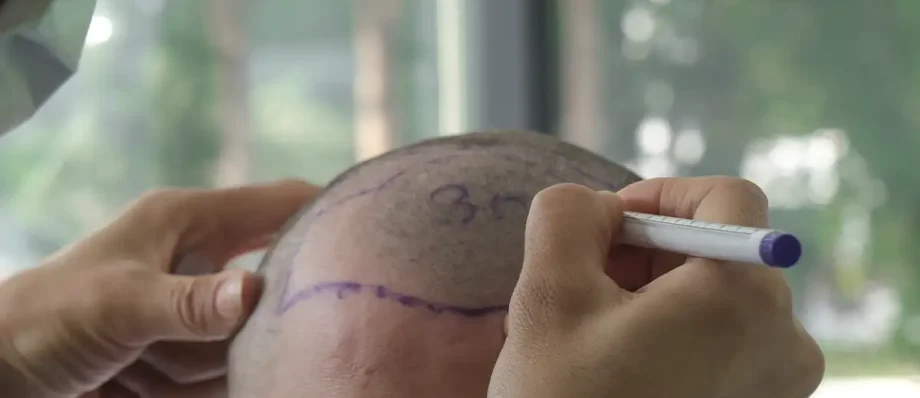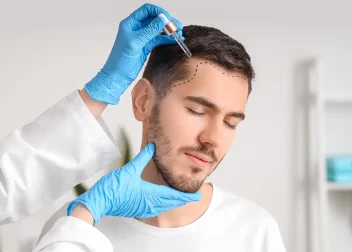What is a Graft in a Hair Transplant?
A graft in a hair transplant refers to a small piece of tissue containing hair follicles that is extracted from a donor site on the patient’s body and transplanted into a recipient site where hair loss has occurred. This technique is commonly used to treat male and female pattern baldness, as well as other types of hair loss such as alopecia areata.
Here is an overview of the grafting procedure, process, and other details involved in a typical hair transplant:
Consultation and Planning:
Before the actual procedure, a consultation with a hair transplant specialist is essential. During this consultation, the doctor assesses the patient’s hair loss pattern, discusses expectations, and creates a customized treatment plan.
The doctor determines the number of grafts needed, the donor area (usually the back or sides of the scalp where hair is more resistant to balding), and the recipient sites (bald or thinning areas where new hair will be implanted).
Preparation:
On the day of the procedure, the patient’s hair in both the donor and recipient areas is trimmed short to facilitate the transplant process.
Local anesthesia is administered to numb the donor and recipient areas, ensuring the patient’s comfort during the procedure.
Extraction of Grafts:
There are different methods of extracting hair grafts, with Follicular Unit Transplantation (FUT) and Follicular Unit Extraction (FUE) being the most common.
In FUT, a strip of scalp containing hair follicles is surgically removed from the donor area. The wound is then closed with sutures.
In FUE, individual follicular units (containing 1-4 hairs) are extracted directly from the donor area using a small punch tool. This method does not involve a linear incision and leaves tiny scars that are less noticeable than FUT scars.
Preparation of Grafts:
Once the grafts are extracted, they are carefully dissected under a microscope to separate individual follicular units.
The grafts are sorted based on their size, shape, and quality to ensure optimal results during transplantation.
Recipient Site Creation:
Using fine needles or blades, tiny incisions are made in the recipient area according to the pre-designed hairline and desired density. The angle, depth, and distribution of these incisions play a crucial role in achieving a natural-looking hairline and overall result.
Graft Implantation:
The prepared grafts are then meticulously implanted into the recipient sites. The surgeon places them one by one, paying attention to the direction and angle of hair growth for a natural appearance.
Care is taken to ensure proper spacing between grafts and to create a gradual transition from areas of higher density to areas with less density.
Post-Procedure Care:
After the transplant, the patient is provided with post-operative instructions, including how to care for the newly transplanted hair and the donor area. Medications may be prescribed to aid healing and promote hair growth. Follow-up appointments are scheduled to monitor progress and address any concerns.
Expectations
A hair transplant, specifically a graft hair transplant, is a surgical procedure that involves moving hair follicles from one part of the body (usually the back or sides of the scalp, where hair is genetically resistant to balding) to another part (typically areas experiencing hair loss or thinning). Here are some expectations associated with grafting:
Natural-Looking Results: One of the primary expectations is to achieve natural-looking results. Skilled surgeons aim to transplant hair follicles in a way that mimics natural hair growth patterns, ensuring that the transplanted hair blends seamlessly with the existing hair.
Hair Density Improvement: Graft in hair transplants can significantly improve hair density in areas where hair is thinning or balding. However, it’s essential to have realistic expectations about the extent of improvement, as the final density can vary based on factors like the donor hair supply and the recipient area’s characteristics.
Permanent Solution: Hair transplants are considered a permanent solution for hair loss in the transplanted areas. The transplanted hair follicles are usually genetically resistant to balding, so they continue to grow hair even after being moved to a new location.
Healing and Recovery: Patients can expect a period of healing and recovery following a graft hair transplant. This may involve some discomfort, swelling, and scabbing in the recipient and donor areas. However, these effects are temporary, and most patients can resume normal activities within a few days to a week after the procedure.
Hair Growth Timeline: It’s essential to understand the hair growth timeline post-transplant. Initially, the transplanted hair may shed within a few weeks after the procedure. This shedding is a normal part of the hair growth cycle, and new hair growth typically begins within a few months. However, the full results may take several months to a year to become evident as the transplanted hair grows and matures.
Maintenance and Care: While the transplanted hair is permanent, it’s essential to maintain good hair care practices to ensure the longevity of results. This includes protecting the scalp from sun exposure, avoiding harsh chemicals or treatments that could damage the hair follicles, and following any post-transplant care instructions provided by the surgeon.
Realistic Expectations: It’s crucial for patients to have realistic expectations about the outcomes of a graft hair transplant. While the procedure can provide significant improvements in hair density and appearance, it may not restore a full head of hair to the extent seen in youth or completely halt hair loss progression in other areas of the scalp.
Overall, a graft in a hair transplant can be an effective solution for addressing hair loss and improving hair density, but it’s essential for patients to have a thorough understanding of the procedure, potential outcomes, and post-transplant care requirements. Consulting with a qualified and experienced hair transplant surgeon can provide personalized guidance and help set realistic expectations based on individual circumstances.
Recovery and Results:
The recovery and results of a hair transplant can vary depending on several factors, including the individual’s health, the technique used, the extent of the procedure, and how well they follow post-operative care instructions. Here is an overview of what to expect regarding recovery and results after a hair transplant:
Recovery Process:
Immediate Postoperative Period (1-2 days): Patients may experience some discomfort, swelling, and redness in the recipient and donor areas. Pain medication and antibiotics are often prescribed to manage pain and prevent infections.
First Week: Swelling and redness start to subside. Patients are advised to avoid strenuous activities and follow a gentle hair washing routine as per the surgeon’s instructions.
2-3 Weeks: Transplanted hair may fall out, which is normal and known as “shock loss.” The scalp may still be sensitive, and scabs may form around the transplanted follicles.
1-2 Months: New hair growth typically begins, and patients may notice small, fine hairs emerging from the transplanted follicles. The scalp gradually heals, and any scabs or redness should diminish.
3-6 Months: Hair growth becomes more noticeable, although it may still appear thin and uneven initially. The majority of transplanted hair should have grown by this time, but final results take longer to fully manifest.
6-12 Months: Continued hair growth and thickening occur, resulting in a more natural and fuller appearance. Patients can expect to see significant improvements in hair density and coverage.
Results:
Natural Appearance: A successful hair transplant should result in natural-looking hair that blends seamlessly with the existing hairline and scalp.
Improved Hair Density: Over time, the transplanted hair follicles should produce thicker, fuller hair, enhancing overall density and coverage.
Permanent Solution: Transplanted hair is typically permanent, as the follicles are taken from areas resistant to balding (donor zone) and maintain their genetic characteristics.
Patient Satisfaction: The level of satisfaction varies, but many patients report increased confidence and satisfaction with their appearance after a successful hair transplant.
Maintenance: While the transplanted hair is permanent, it’s essential to continue good hair care practices and follow-up with periodic check-ups to ensure optimal results and address any concerns.
It’s crucial to consult with a qualified and experienced hair transplant surgeon to discuss expectations, potential risks, and post-operative care instructions specific to your situation. Each individual’s experience with recovery and results can differ, so personalized guidance is key to a successful outcome.


